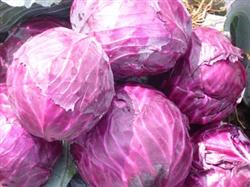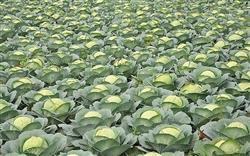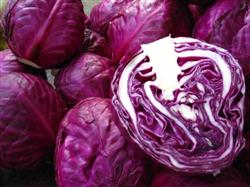How to grow purple cabbage without pollution?

How to grow purple cabbage without pollution? Please give technical guidance to purple cabbage alias red cabbage and purple cabbage. A variety of Brassica oleracea in the cruciferous family that forms purple leaf balls and is a biennial herb. Native to the Mediterranean coast. Purple leaf ball as the edible organ, contains a variety of vitamins and minerals, especially rich in vitamin C. Therefore, although purple cabbage has not been cultivated and eaten for a long time in China, it is very popular because of its rich nutrition and beautiful color. It has been 6 years since Wuji County began to plant purple cabbage in 2001, and some cultivation experience has been accumulated through several years of practice. First, the arrangement of cultivation season and stubble purple cabbage likes a mild climate, but it also has cold resistance and heat resistance. The optimum temperature for seed germination is 18 ℃ 22 ℃, and it can also germinate under the condition of 25 ℃ 30 mol. The optimum temperature for the growth of outer leaves was 20ml / 25 ℃. The optimum temperature for pilling is 15-20 ℃. Wuji County can be cultivated in both spring and autumn. Spring cultivation generally raised seedlings in greenhouse at the end of January and planted in open field at the end of March, while autumn cultivation generally raised seedlings in shade at the beginning of June and planted in open field in mid-July. Second, cultivation and management 1. Select suitable varieties. At present, most of the varieties are introduced from abroad, the main variety in our county is Zigan 1, which is a medium-mature variety with large plant type, large growth potential, 65-70 cm development, 18-20 outer leaves, purplish red leaves and more wax powder on the back. The leaf ball is spherical, the weight of single ball is 2-3 kg, and the yield per mu is 3000-3500 kg. From planting to harvest, it has strong storage and disease resistance, so it is suitable for protected field in spring, open field and open field cultivation in summer and autumn. two。 Prepare the land and make the border. Purple cabbage has strong ability to absorb fertilizer. The land should be ploughed deeply and leveled into a bed 1-1.2 meters wide. 5000 kg of organic fertilizer, 25-30 kg of phosphate fertilizer, 30-40 kg of urea and 20-30 kg of potash fertilizer are applied per mu. Purple cabbage contains calcium second only to nitrogen, such as lack of calcium will produce dry heartburn, so it is necessary to properly supplement some calcium fertilizer. 3. Sow seeds and raise seedlings. Purple cabbage is generally cultivated by seedling and transplanting. When raising seedlings and sowing seeds, the seed amount is 50-100 grams per mu. After emergence, the temperature of cotyledon stage was 15-20 ℃, and that of true leaf stage was 18-22 ℃. It should be gradually close to the external temperature 5-7 days before planting. Spring purple cabbage was planted in the open field at the end of March and early April. Sitting water planting is beneficial to improve the soil temperature and slow down the seedlings; when planting purple cabbage in autumn, it can be planted first and then irrigated to preserve soil moisture. The plant-row spacing of early-maturing varieties was 50 cm × 50 cm, with 2500-2600 plants per mu, and that of middle-maturing varieties was 50 cm × 60 cm, 2200 plants per mu. 4. Seedling management. Before sowing, the seedling bed should be thoroughly watered, and the seedlings and planting should be watered thoroughly so as not to hurt the roots. In addition, try not to water. 5. Rosette management. After watering slow seedlings for 1-2 times, they entered the squatting seedling stage, and during this period, they were ploughed for 2-4 times. The first intertillage should be deep and comprehensive, in order to preserve soil moisture and promote root growth; in the middle of the rosette, shallow ploughing should be combined with soil cultivation to promote short stems and more roots, which is conducive to heading. Squatting seedlings for about 20 days. When you begin to bear balls at the end of rosette, you should irrigate a lot of water. 6. Management of the ball closing period. During this period, the leaf bulb grew fast and needed a lot of water, and the ground was generally watered as soon as it was dry until harvested. 7. Harvest. When the leaf ball reaches quite tight, it can be harvested in real time. Cut off the root stalk during harvest, remove the outer leaves and damaged leaves, so that the leaf ball is clean without soil. 8. Pest control. (1) disease. In the seedling stage to prevent the occurrence of sudden collapse disease, to properly control moisture, more ventilation and light. In the heading period, it is mainly to prevent the occurrence of soft rot, especially in summer and autumn. It is necessary to prevent stagnant water and remove the diseased plants in time. Spraying with 100-150 mg / kg agricultural streptomycin has a certain control effect. The phenomenon of burning edge is also easy to occur in the heading period, so it is necessary to maintain soil moisture to facilitate the absorption of calcium. In addition, spraying some calcitonin on the leaves also has a certain prevention and control effect. (2) insect pests. Mainly aphids and cabbage insects. Aphid control: timely removal of weeds, residual plants, dead leaves. 50% aphid repellent wettable powder or imidacloprid 1000 times liquid spray can be used. Control of Pieris rapae: avoid continuous cropping or interplanting with vegetables of the same family. Pyrethroids pesticides can be used for chemical control. Click to get more cabbage planting techniques click to get more vegetable planting techniques
- Prev

What do you need to pay attention to when planting purple cabbage?
What do you need to pay attention to when planting purple cabbage? Compared with common cabbage, purple cabbage has the characteristics of longer growth period, compact head, bright color, good storage and transportation resistance and good quality. First, geographical selection purple cabbage likes cold, cold, belongs to low temperature, long sunshine, natural cross-pollinated vegetables. System...
- Next

How can purple cabbage be planted with high yield?
How can purple cabbage be planted with high yield? Please introduce purple cabbage, also known as red cabbage, purple cabbage and so on. This kind of cabbage is cold-resistant and heat-resistant, strong adaptability, high yield, transportation resistance, growth period of 90-120 days, is one of the rare vegetables in Shandong Province, the economic benefit of planting purple cabbage is much higher than that of common cabbage varieties. ...
Related
- Where is it suitable to grow horseradish in China? it is expected to see the middle altitude horseradish in Alishan.
- How to prevent tomato virus disease reasonably? (Control methods included)
- Many people like to plant towel gourd on the balcony. What are the main points of this method and management?
- What crops can chili peppers be mixed with?
- Fertilization techniques and matters needing attention in Tomato
- What are the grafting techniques for peach seedlings in spring?
- Harm and control methods of root swelling disease of Chinese cabbage
- What are the pests of sweet potatoes? How to prevent and cure it?
- Symptoms, causes and Control methods of navel Rot in Tomato
- The cause of "Cucumber rotten bibcock" in Farmers' planting Cucumber and its Control Plan

